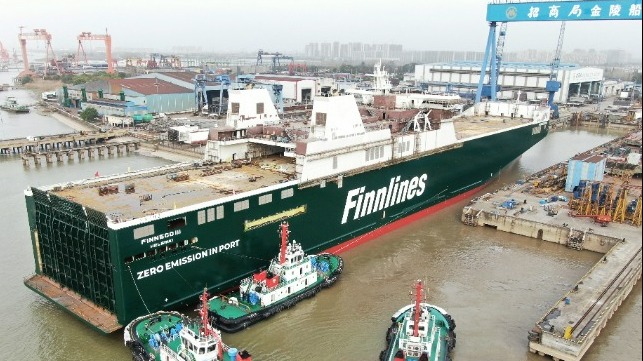Finnlines Launches Third "Eco" Hybrid Ro-Ro in China

Finnlines is set to take delivery of its third hybrid ro-ro vessel, Finneco III, recently launched at China Merchants Jinling Shipyard (Jiangsu). The new carrier is part of Finnlines’ ongoing $560 million newbuilding program.
“Our ambitious strategy to expand services is a response to growing demand. We will bring a total of five new vessels to traffic over the next few years, which will increase our cargo and passenger capacity significantly,” said Emanuele Grimaldi, CEO and president of Finnlines.
He added the shipping line - which is part of the Grimaldi Group - is improving its performance while reducing the environmental impact of its fleet.
“The hybrid vessels will be among the most innovative and efficient ships in the world and are part of the investments we make in the responsible and sustainable operations of our fleet,” he said.
The Finneco III ro-ro vessel is 780 feet long with a cargo capacity of 5,800 lane-meters. Compared to the company’s largest ro-ro vessels today, cargo capacity increases by nearly 40 percent.
The new vessels incorporate a swath of complementary power technologies: lithium-ion battery systems, two-stroke diesel engines, exhaust treatment systems, solar panels and an air lubrication system to reduce hull friction. Several existing ships will also be equipped to use onshore power as the company gradually transitions to carbon-free and renewable fuels.
Finnlines operates in the Baltic Sea, the North Sea and the Bay of Biscay, with liner services to the Mediterranean, West Africa and the Atlantic coast of the Americas.
In the nine months from January to September, the company transported 583,000 cargo units, shipped 124,000 cars, and carried 1,041,000 tons of freight. Private and commercial passenger numbers stood at 439,000.
The company’s revenues increased by 17 percent to $480 million from $410 million in the same period in 2020. EBITDA increased to $136 million compared to $120 million the previous year.
